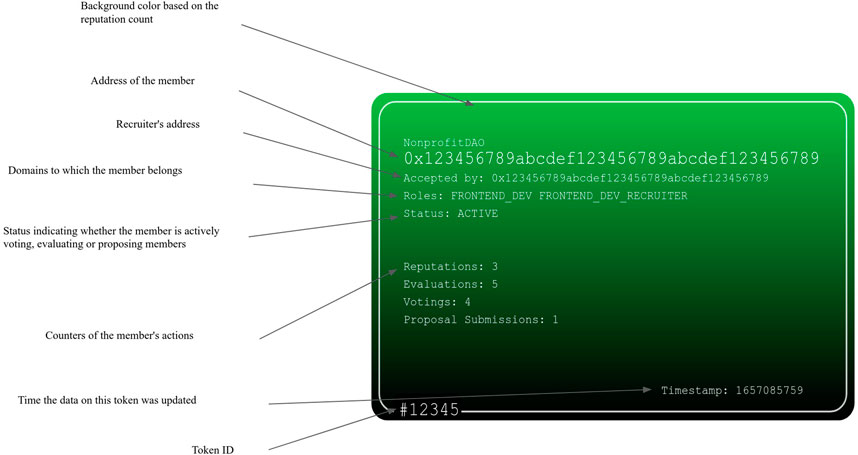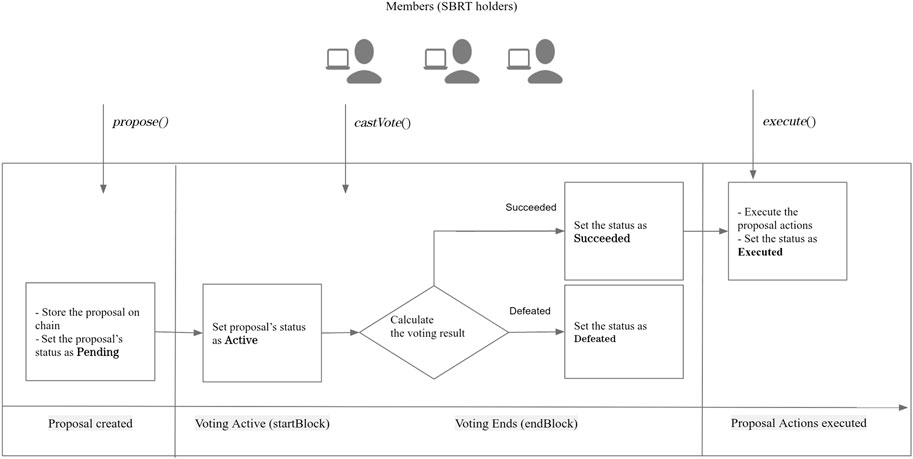- Ritsumeikan Asia Pacific University, College of Asia Pacific Studies, Beppu, Oita, Japan
The Decentralized Autonomous Organization (DAO), a group organized by governance rules programmed on a blockchain, has recently been attracting attention as a novel organizational form. The effectiveness of a DAO’s decentralized governance mechanism and transparency, as secured by its code, has generally been discussed in contrast with traditional stock companies. However, the potential of a DAO for non-profits, which provide goods and services that profit-seeking organizations do not offer, has been less discussed. This paper presents a proof-of-concept implementation to demonstrate the advantages of utilizing a DAO governance framework for non-profits. To this end, this study developed a DAO governance framework incorporating a reputation-based decision-making system, a peer evaluation system, and a transparent, real-time accounting system for the Ethereum blockchain. Most current decentralized governance systems rely heavily on token-based voting using governance tokens with stock-like features. However, there is a need for a voting mechanism beyond token-based voting for non-profits, which do not have owners. Therefore, the developed application applies an existing reputation-based voting mechanism and integrates additional features, such as a membership system with mutual evaluation and a reputation NFT to visualize contributions. Several exemplar demonstrations were conducted to evaluate its key functionalities. This application enabled discussions across the boundary between technology and society in terms of the key aspects of non-profits: i) transparency of finance and governance, ii) participatory governance by diverse stakeholders, and iii) equity and inclusiveness of the consensus mechanism. The results indicated that blockchain technology compensates for a non-profit’s vulnerabilities, and illustrated that the proposed reputation-based governance mechanisms are well-motivated. However, the results also revealed that blockchain-based governance involves as many potential risks and limitations as it brings benefits. Lastly, by providing several possible solutions to these constraints as well as recommendations for future research, this paper contributes to the sustainable development of non-profits as one of the foundations of democratic governance.
1 Introduction
In today’s era of diversifying needs and shrinking public provision, non-profits play an integral role in our community, meeting diverse demands, fostering civic participation, and strengthening the broader community. Theories of non-profits have been established in a variety of domains for many decades. In economics, according to Weisbrod (1991), the non-profit sector’s raison d’etre is to distribute resources efficiently to fill the gap left by “market failures” and “government failures” caused by information asymmetry, externalities, and inequitable impact. In addition, Salamon (1987) articulated the “voluntary failure” that the non-profit sector also fails to provide resources adequately due to insufficiency, particularism, paternalism, and amateurism. Previous research generally confirms the importance of adopting and practicing good governance in operating non-profits to mitigate their weaknesses and make them sustainable and autonomous (Yeo et al., 2017; Gálvez-Rodríguez et al., 2020; Hayase, 2020).
Blockchain, which is one of the most cutting-edge technologies to emerge in the last decade, has received substantial attention since it burst onto the scene in 2008. As a field that is still in its infancy, there are a plethora of potential applications in various domains, and the movement to incorporate blockchain technology into traditional systems is gaining momentum around the world. For example, in sub-Saharan Africa, there is a growing market for cryptocurrencies based on blockchain technology, with a large proportion of users now utilizing such currencies for regular financial interactions, such as savings, retail commerce, and international remittances, rather than as a vehicle for speculation, thus deeply integrating cryptocurrencies into their daily financial activities (Grauer et al., 2022b). Another example is the adoption of the first such cryptocurrency, Bitcoin, as legal tender by El Salvador in September 2021, with the aim of promoting financial inclusion for the approximately 70 percent of Salvadorans who do not have access to traditional financial services (Aleman, 2021; Government of El Salvador, 2021). Furthermore, its potential extends beyond digital money. In December 2021, Dubai officially announced that it had completed a full transition to a paperless government. Blockchain has contributed significantly to its implementation (Government of Dubai, 2021; Malak, 2021). However, this relatively immature technology simultaneously raises new challenges. For instance, Grauer et al. (2022a) reported that the blockchain industry is fueling a large number of criminal activities, including money laundering, malware, dark web markets, and scams.
This paper aims to contribute to the development of non-profits by investigating the impact of a blockchain-based governance framework for non-profits. While there have been several academic attempts at utilizing blockchains for non-profits, most previous research focuses on using a blockchain for specific processes such as donations and transfers of operating funds (Marinelli, 2019; Turfa, 2019; Shin et al., 2020). This study discusses the impact of moving an NPO’s decision-making process and internal evaluation process onto a blockchain, in addition to financial operations. A prototype for a DAO-based governance framework was developed, and several exemplar demonstrations were conducted on a private blockchain to confirm its essential functionality. The source code is hosted on Github (Saito, 2022). Note that due to time constraints, experimental social work for evaluating the effectiveness of this prototype is beyond the scope of this study. Also note that in the context of the current study, the term governance is used in the restricted sense of referring to the internal governance process within a single organization (i.e., generation and decision-making regarding proposals for NPO activities, etc.). For a more general review of governance from a higher-level (i.e., whole-society or community) perspective, the reader is directed to “Decentralized Network Governance: Blockchain Technology and the Future of Regulation” (Zwitter and Hazenberg, 2020).
This paper is divided into five sections:
Introduction: This section first provides a background on the significance and weaknesses of non-profits and the impact of blockchain technology, citing news and prior research, and states the research objective. In addition, this section briefly describes the various concepts that form the basis of this study, including the basic concepts of Blockchain, Smart Contracts, Decentralized Autonomous Organizations, and governance of non-profits.
Methods: This section outlines the application development methods, with reference to the actual code and figures. The applied method comprises setting up a blockchain development environment, designing a governance framework, and implementing the required smart contracts.
Results: This section presents several exemplar demonstrations to verify the key functionalities of the application, along with several illustrative screenshots. The demonstrations include the typical series of operations involved in the decision-making process, as well as the peer evaluation process.
Discussion: This section discusses the results and recent developments from technical and social perspectives. It includes a general discussion, a technical discussion on the developed governance system, research limitations, and recommendations for future research.
Conclusion: This section summarizes the discussion and concludes with a review of the research objective.
1.1 Blockchain and Bitcoin
The concept of Bitcoin and Blockchain was initially described in a whitepaper written in 2008 under the alias of Satoshi Nakamoto (Nakamoto, 2008). The paper proposed a system for electronic cash that does not rely on trust by combining developments in cryptography, distributed processing, and game theory. The term “Bitcoin” refers to the electronic cash system, while “Blockchain” refers to the technology underlying Bitcoin. Blockchain essentially provides a decentralized, transparent, and immutable ledger, building a consensus within a distributed system through various techniques from cryptography. With this globally single-state ledger, Bitcoin realized electronic cash along with an associated payment network. The following paragraphs will explain the three main components of blockchain technology.
The first component is a Peer-to-Peer (P2P) network. In a P2P network, all nodes (computers) interconnect directly without a central server. All nodes are equal, and they share the burden of providing network services. The ledger of all transactions is shared and synced among all nodes participating in the Bitcoin network via a P2P network, and is publicly available (Antonopoulos, 2017).
The second component is the Blockchain data structure. The ledger is stored in the form of an ordered list of blocks containing transactions, with each block including an encrypted reference to the previous block. Since each block is linked to the previous block and guarantees its integrity, data on the blockchain cannot be changed retroactively without affecting all subsequent blocks (Voshmgir, 2019).
The third component is the Consensus algorithm. To reach a distributed consensus on which the blockchain is valid and sustains its single state, Bitcoin adopts a consensus algorithm called Proof-of-Work (PoW). Simply put, only a single participant, who has properly validated new transactions to assemble a new block and solve a difficult mathematical problem the fastest, by expending a massive amount of computing effort, is permitted to add the next block to the blockchain (Antonopoulos, 2017). This participant receives newly issued bitcoins and transaction fees from users as a reward for their contribution to bitcoin security. The process of transaction validation, computing effort, and the issuance of bitcoins is known as “mining” and is carried out by participants known as “miners.” The mining time is set at approximately 10 min in Bitcoin, and a new block is added to the blockchain every mining process. Since all blocks are connected, once a block is added to the blockchain, it cannot be changed without redoing the mining, which requires enormous computing power. The cost of such a change increases exponentially with each new block added, reinforcing the security of the blockchain (Nakamoto, 2008).
As seen above, Nakamoto invented Bitcoin as an alternative to traditional money, along with the decentralized, transparent, and immutable blockchain system. A full description of Bitcoin and Blockchain is beyond the scope of this research study. However, interested readers will be able to find high-level and in-depth descriptions in “Bitcoin: A Peer-to-Peer Electronic Cash System” (Nakamoto, 2008) and “Mastering Bitcoin” (Antonopoulos, 2017), respectively.
1.2 Ethereum and the world computer
Numerous blockchains with various properties have been developed since the inception of Bitcoin. Ethereum is one of them. Ethereum was launched by Vitalik Buterin, Gavin Wood, and other blockchain enthusiasts in 2015 (Antonopoulos and Wood, 2018). While Bitcoin and Ethereum are powered by the same decentralized ledger, they differ in many ways. For instance, while Bitcoin realizes a digital cash system by storing transactions on a blockchain, and computing account states (bitcoin balance), Ethereum repurposed it for more general usage. Ethereum utilizes a blockchain to store arbitrary and complex programs, and runs them on a virtual machine implemented on a blockchain, known as the Ethereum Virtual Machine (EVM). Thus, Ethereum functions as a single-state distributed world computer (Antonopoulos and Wood, 2018; Dameron, 2019).
The programs are generally called Smart contracts. Anyone can upload a smart contract on Ethereum and run the program by paying a network fee called “gas” to the miner. On Ethereum, users are required to pay gas with a native cryptocurrency called “Ether.” From a more technical perspective, a smart contract represents an account attached to an arbitrary program including functions and data storage. Users can alter the contract’s data by broadcasting a transaction containing the required parameters to the Ethereum network. The distinctive nature of smart contracts is that they are always executed exactly as programmed and anyone can readily verify state changes (Solomon, 2019).
One of the leading use cases of smart contracts is Decentralized Finance (DeFi). DeFi offers a variety of financial services, including exchange, lending, derivatives, and insurance, without relying on centralized financial institutions (Schär, 2020). All processes are automatically executed by smart contracts, eliminating counterparty risk. Any user with Internet access can use these services, regardless of their region, nationality, or status (Ethereum.org, 2022a). The DeFi industry is growing rapidly. DeFi Llama (2022) estimates the total funds currently locked in smart contracts related to DeFi at roughly 53 billion (USD), as of October 2022. Please note that this number is dependent on their calculation methodology.
1.3 Decentralized Autonomous Organization
The creation of a Decentralized Autonomous Organization (DAO) is another use case for smart contracts. A DAO is a mission-driven group with internal capital that is organized through an automated decision-making mechanism on the blockchain (Buterin, 2014; Xie, 2021). It usually has a built-in treasury that no one can access without the group’s approval. All decisions of the DAO are controlled by proposals and voting (Ethereum.org, 2022b). These governance rules are encoded into smart contracts deployed on the blockchain, bringing transparency to the entire governance process, and it operates autonomously without any centralized actor (Hassan and De Filippi, 2021). Compared with traditional organization forms, these characteristics allow organizations to be more global and non-hierarchical, and a DAO enables worldwide collaboration and coordination to pursue collective objectives (Ethereum.org, 2022b). In recent years, practical attempts to utilize a DAO have been actively carried out in the DeFi domain. Many DeFi services leverage a DAO to adjust the parameters of smart contracts to maintain the efficiency of the service (Compound, 2022; MakerDAO, 2022).
DAO voting systems come in various flavors, of which the most commonly used is token-based voting. Token-based voting vests the power directly with the holders of tokens issued by a DAO, in proportion to the amount of tokens, eliminating executive teams that could become targets of censorship, manipulation, or bribery (Parton, 2021). The tokens representing the right to participate in governance are usually called “governance tokens” and have economic value, as these tokens can be exchanged for other cryptocurrencies on a DeFi service. Any user can buy tokens and participate in governance. Since the governance token’s price depends on the organization’s value, the token is similar to traditional organization equity or ownership, although the scope for making changes is more limited (Mart and Yi, 2021).
Reputation-based voting is another voting mechanism. In reputation-based voting, voting rights are represented by tokenized reputations, rather than governance tokens. Such a reputational token has the following two characteristics: it is Non-transferable and Destroyable (Burnable) (Levi, 2019). A reputational token is tied to each user’s address and is impossible to transfer or burn by the holders. If a reputation-holder does not act according to social or democratic norms, the community can burn that holder’s reputational token as punishment, accordingly. Users can increase their reputations by staking tokens or completing tasks, but cannot buy or lend reputations (i.e., their reputational tokens), unlike governance tokens (DAOstack, 2018; Rea et al., 2018).
Various other voting systems have been developed by changing the parameters of these voting mechanisms, such as Quadratic founding (Gitcoin, 2022), Voting escrow (Curve Finance, 2022), Conviction voting (Aragon, 2022), Liquid democracy, and Signature voting (Snapshot, 2022).
1.4 Governance of non-profits
This section will review prior studies on the governance of non-profits. These studies indicate that practicing good governance, such as transparent disclosure of financial and non-financial information and participatory governance and activity, is related to the autonomy and sustainability of non-profits, and is a prerequisite for operating such an organization.
Non-profits receive benefits from good governance in many areas. Practicing good governance promotes the development of strong organizational plans and strategies through an assessment of an organization’s operations and delivery processes for effectiveness and efficiency. Focusing on governance opens up new possibilities for non-profits to improve involvement and communication with their stakeholders (Price, 2017).
Transparency is essential for non-profits to achieve an acceptable level of accountability to stakeholders such as individual donors, governments, beneficiaries, and volunteers. Stakeholders can monitor the process, learn about the benefits and impacts of the NPO’s activities, and confirm how to help the organization. Effective accountability requires proactive information disclosure and appropriate communication systems such as websites and social networking services. Aside from financial statements, the disclosure should include projects’ actual benefits and impacts, as well as narrative information about future projects (Gálvez-Rodríguez et al., 2020).
Donors are more interested in basic information, such as information about the organization’s objectives and management staff, the performance of services and projects using donated funds, and information about governance structures and decision-making processes, than in financial statements (Yeo et al., 2017).
Stakeholder participation and stakeholder engagement are crucial in the management of non-profits, to ensure that their opinions and shared values are reflected in the governance and decision-making of the organization. Although non-profits are motivated to achieve social benefits, they are hindered by limited resources. Therefore, non-profits are expected to collaborate with other non-profits, corporations, and civil society organizations. However, collaboration among these different sectors and organizations can be challenging (Cooper, 2014).
Non-profits need to provide services to beneficiaries and simultaneously offer opportunities for participation to supporters through volunteer programs. Fostering civic involvement can create a situation where supporters are more likely to solve social issues and actively enhance social cohesion. In addition, supporters build further trust in organizations, strengthening their financial base (Hayase, 2020).
1.5 Non-profits and blockchain
This section will review previous research on utilizing blockchain technology for non-profits. Most academic studies have focused on the donation process or fund transfer process using blockchain technology. Furthermore, several real-life examples of non-profit mission-based projects utilizing blockchain are presented.
With blockchain, operational transactions are truly transparent, and can be shared with multiple participants in real-time, allowing for efficient and transparent operations. As a consequence, this promotes donations. In addition, smart contracts reduce staff’s administrative and managerial tasks, allowing them to focus more on the organization’s core activities (Shin et al., 2020).
By eliminating the need for a third party to manage transactions and records through Blockchain, transaction costs can be significantly reduced or even eliminated. Blockchain technology can improve the financial efficiency of charities, save large amounts of money, and increase the trust of donors and supporters (Davies, 2015).
On the other hand, since blockchain systems are often open-source systems, they could be subject to attacks by hackers, or third parties could bring weaknesses or flaws into the core of the system. Theft or loss of funds on the blockchain is a fatal risk, and if it happens, fund recovery is generally a difficult or impossible task (Marinelli, 2019).
KlimaDAO (KlimaDAO, 2022), which was founded to solve the problems of carbon credit markets, is one real-world example of a non-profit mission-based DAO. Their organizational decisions are made via token-based voting by the core team, contributors, and governance token holders. Giga (Giga, 2022) is another leading example of a project that leverages blockchain. They offer a blockchain-based solution for the lack of Internet access of schools in developing countries. They do not use blockchain as a governance tool, but as a tool to automate payment systems and to fundraise for school connectivity.
2 Methods
This section discusses the development process of the prototype (Saito, 2022), a DAO framework for non-profits, for this research study. Before discussing details, the high-level structure and design of the prototype are presented to clarify its essential concepts. The prototype can be broken down into the following two core components: i) autonomous and transparent decision-making to determine the organization’s direction; and, ii) reputation-based membership based on a peer evaluation system. To embed the core elements into this prototype, two smart contracts have been developed, along with front-end software that allows users to communicate with the smart contracts from a web page. These smart contracts each play key roles and work in tandem (Figure 1). The following subsections present the key process of building a DAO framework for NPOs, separating the process into three steps. Since this study focuses on a discussion of the developed smart contracts, this paper does not provide the details of the front-end software.
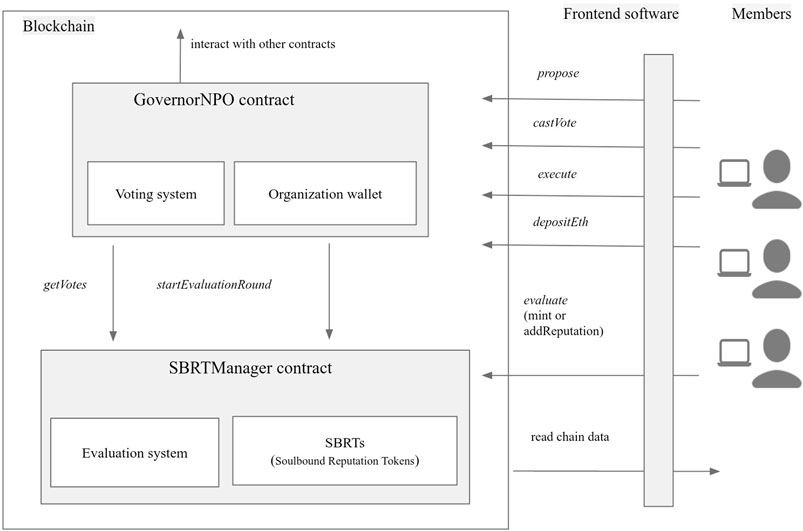
FIGURE 1. The high-level architecture of the presented DAO framework for non-profits. Note that italicized words represent function names for interacting with the smart contracts.
2.1 Designing the Decentralized Autonomous Organization
2.1.1 Decision-making system
This study applies reputation-based voting to obtain a consensus among all contributors. Although token-based voting has been widely used as a powerful governance tool, it has several vulnerabilities. Vitalik Buterin, one of the co-founders of the Ethereum protocol, pointed out several vulnerabilities of token-based voting (Buterin, 2021). One vulnerability is vote-buying. In most token-based voting, a token is intentionally designed to grant two rights: economic interest in the organization’s value and participation rights in governance. The goal is to align responsibility and governance power, in a manner similar to traditional stocks. However, these two rights can easily be separated by wrapping the token or borrowing the token from a DeFi platform. As a result, an attacker can gain governance power without assuming financial risk, leading to decisions that the organization does not want to make.
In addition, in token-based voting, tokens are directly tied to ownership of the organization. According to a research paper published by DappRadar and Monday Capital concerning decentralized governance in the DeFi field (Stroponiati et al., 2020), a few wealthy participants hold more than half of the total circulation of the governance tokens in some major DeFi services. Thus, despite their decentralized infrastructure, their governance has become more centralized via the application layer. In contrast with for-profit companies, a non-profit entity has no shareholders and carries out actions for the benefit of the public, not that of the shareholders. Given this situation, the organization’s decisions should be determined by contributors who have established a certain level of reputation, not by wealthy participants seeking additional economic value. If a contributor has shared value among the community, their decision should be more likely to lead to desired results toward achieving the organization’s mission.
For the above reasons, this study has applied reputation-based voting to obtain a consensus among all contributors. In reputation-based voting, users stake their non-financial resources such as time and knowledge to prove their enthusiasm, and reputations assigned by other members represent voting rights.
2.1.2 Reputation and peer evaluation
As with real-world concepts of reputation, reputational tokens are created only in the process of evaluation, in consideration of a user’s contributions. In addition, such a tokenized reputation is tied to each user’s address, and is impossible to transfer or burn (i.e., destroy) by the voters themselves. Since users are not able to buy or lend their reputational tokens, reputation-based voting has a resiliency to malicious vote-buying, to some extent. As mentioned in the introduction section, reputation can be destroyed by a community decision. The only way for a user to increase their reputation is to contribute to the organization, and then be selected by evaluators in an evaluation round.
In addition, this prototype also applies the reputation decay mechanism of the Colony network (Rea et al., 2018). To encourage users to engage in continuous contributions, each positive evaluation that contributes to a user’s reputation has an expiration date, since newer evaluations are more important, just as in the real world. Once the expiration date of an evaluation has passed, that evaluation no longer counts toward the total reputation that determines the user’s voting rights.
Furthermore, evaluations between individuals reinforce the sense of community and foster effective communication. A set of evaluation processes also enhances transparent governance, leading to good governance. External persons can examine the organization’s output, who contributes, and how to contribute to the project. However, the evaluation system is still a part of this DAO that should be examined carefully, since this process depends heavily on the fragile resource of personal trust.
2.1.3 Integration of reputation into Soulbound Tokens (SBTs)
Soulbound Tokens (SBTs) are non-transferable, non-fungible tokens (NFTs) that are bound to user addresses. SBTs represent commitments, credentials, and affiliations (Weyl et al., 2022), and this concept fits nicely into our reputation system. This prototype utilizes SBTs as membership NFTs that accumulate and visualize a user’s reputational history. In this project, the membership NFTs are referred to as Soulbound reputation tokens (SBRTs), and only SBRT holders are allowed to participate in voting and peer evaluations. An SBRT is only issued when a member who already owns an SBRT gives a positive evaluation to a contributor who does not have an SBRT. The new member then succeeds in obtaining participation rights in governance along with the SBRT, which holds their first evaluation, and will also hold subsequent evaluations. This action can be regarded as a recruitment process for the new member.
Figure 2 illustrates an example instance of the SBRT implemented in this project. The background color of the token changes, depending on the number of positive evaluations the token holds. If the token holds five or fewer evaluations, the background color is green; if it holds from six to ten, the background color is blue; and if it holds from eleven to fifteen, the background color is yellow. This transition of background color helps other users intuitively recognize the holder’s overall contributions. In addition, the SBRT also contains additional data regarding the holder’s history, activity, and status, as well as the address of the recruiting member, establishing a limited form of recruiter accountability.
Using the above components, the organization carries out projects for its mission by iterating a four-step process: i) discussion and planning, ii) a proposal and vote, iii) project execution, and iv) peer evaluation of contributors.
2.2 Setting up the Ethereum development environment
The prototype was developed on the Linux OS (Ubuntu 20.04) using “Node.js,” a JavaScript runtime environment, and “npm,” a package manager for Node.js. This process does not depend strongly on the choice of operating system, since all of the tools introduced in this section are available on macOS and Windows.
There are several different ways to develop smart contracts. In this study, the smart contract was written in Solidity (https://soliditylang.org/), and developed using a smart contract development framework called Foundry (https://github.com/foundry-rs). Solidity is a high-level language for smart contracts. It must be compiled to a low-level language called “EVM bytecode” by a solidity compiler (solc), and then run deterministically on the EVM (Antonopoulos and Wood, 2018; Dameron, 2019). This prototype has adopted solc (version 0.8.13) to compile solidity code. This paper does not provide a detailed overview of the Solidity language; interested readers are referred to (https://docs.soliditylang.org/en/latest/) for an in-depth discussion of Solidity.
One notable difference between smart contract development and traditional application development is that developers cannot modify the smart contract code once they have deployed it to the network, due to the immutability of the blockchain. Therefore, smart contract code must be carefully tested and determined to be bug-free before being deployed to the live public blockchain (Solomon, 2019). Foundry is a toolkit to mitigate these concerns. It primarily provides a testing framework and a local blockchain for development and testing. Figure 3 (left) shows the console screen when the Anvil local chain is started up. Anvil provides pre-funded accounts for testing. Alternatives to Foundry include Truffle (https://trufflesuite.com/) and Hardhat (https://hardhat.org/).
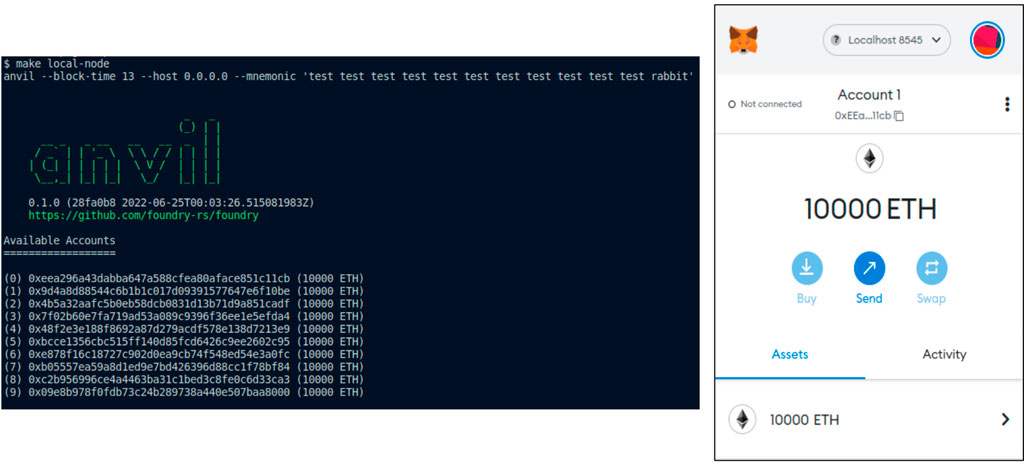
FIGURE 3. Left: The Anvil local chain. Right: The Metamask wallet extension. The accounts are generated based on the given mnemonic phrase. The block time is set at 13 s to simulate the Ethereum mainnet.
The front-end software was written in JavaScript and its framework, React (https://reactjs.org/). It interacts with the blockchain via a browser extension called the MetaMask Wallet (https://metamask.io/). It allows users to interact with smart contracts via the user’s address. For end-to-end testing, the pre-funded accounts provided by Anvil are imported into MetaMask. Figure 3 (right) shows the MetaMask wallet extension UI.
2.3 High-level overview of the implementation
2.3.1 The GovernorNPO contract
The GovernorNPO contract was implemented based on the Governor contract provided by OpenZeppelin1 and refactored to meet our requirements, namely reputation-based voting rather than token-based voting.
Interested readers can find more information on the technical document of the contract (https://docs.openzeppelin.com/contracts/4.x/api/governance). This contract’s roles are: i) managing a voting system, ii) interacting with other accounts as a decision of the organization, and iii) storing organization funds (the organization wallet). The key functions that the user can invoke in the GovernorNPO contract are as follows:
• propose(): A function which only SBRT holders can call, with the following five arguments.
– domainId: The domain ID of the proposal. The default value is 0.
– targets, values, calldatas: The elements of the proposal actions2.
– description: A human-readable description of the proposal.
• castVote(): A function that only SBRT holders can call, only when the status of a proposal is Active, which takes the following three arguments.
– proposalId: A unique proposal ID for identifying individual proposals.
– support: An integer indicating 0 for Against, 1 for For, and 2 for Abstain.
– reason: (optional) A string indicating the reason for the vote.
• execute(): A function that anyone can call, with the following arguments, only when the status of a proposal is Succeeded and the block number has reached a set executeBlock.
– targets, values, calldatas: The elements of the proposal actions.
– descriptionHash: A hash of the description of the proposal.
• depositEth(): A function which is used when depositing ether to this contract along with a reference. This function has the following argument:
– reference: A data string indicating the purpose of the deposit (e.g., donation, payment).
Figure 4 illustrates the lifecycle of a proposal showing the timeline, user actions, and contract operations. The first step is for the proposer to call the propose() function. The GovernorNPO contract first validates the given parameters, and then queries the SBRTManager contract by calling the getVotes() function to verify that the proposer holds an SBRT (The SBRTManager contract will be discussed later). If all conditions pass, the GovernorNPO contract creates a proposal along with a startBlock, endBlock, and proposalId, and stores it in the proposal registry. The startBlock and endBlock variables represent the proposal’s voting period as block numbers3 and are calculated based on hardcoded parameters in the smart contract. The proposalId is a unique ID to identify individual proposals, which is calculated by hashing the targets, values, calldatas, and description.
When the block number reaches the startBlock, the proposal’s status becomes Active. From this point, SBRT holders can call the castVote() function using the proposalId, while indicating their preference via support. The details of the voting are stored in the proposal registry.
Afterwards, when the block number reaches endBlock, and the voting period has expired, the proposal status changes to either Succeeded or Defeated, depending on the voting result. If it becomes Succeeded, execution of the proposal’s action will be enabled. On the other hand, if it is Defeated, the proposal is canceled.
If the proposal is passed and a user calls the execute() function, the proposal actions are executed by this GovernorNPO contract. Proposal actions can be used for payment, funding, starting an evaluation round (discussed in the next section), and setting a project’s parameters.
This contract also functions as an organization’s wallet. Therefore, users can donate ether to this GovernorNPO contract by calling the depositEth() function, along with the reference, or send ether to the contract without a reference. The ether is stored in the contract’s balance, and can be used for the organization’s expenses such as payment and funding, based on voting results.
2.3.2 The SBRTManager contract
This contract’s roles are: i) managing a peer evaluation system and ii) managing SBRTs along with users’ action histories. The key functions in the SBRTManager contract are as follows:
• setEvaluationRound(): A function that only the GovernorNPO contract can call. This function sets a new evaluation round and starts the evaluation period.
– domainId: The domain ID of the proposal. The default value is 0.
– startBlock: The block number at which the evaluation period starts.
• evaluate(): A function that only SBRT holders can call during an evaluation period.
– roundId: A unique evaluation round ID, which identifies an individual evaluation.
– contributors: An array of addresses of users who have been selected by the evaluator to receive a positive evaluation.
– reasons: An array of strings listing the reasons for the evaluations.
• getVotes(): A function that calculates the current voting power amount of a specific user, based on the user’s actions. This function has one argument.
– account: The user’s address.
• tokenURI(): A function that returns the Data URI of a specific token. This function has one argument.
– tokenId: A unique token ID, which identifies each individual token.
First, the evaluation system works as follows. In order to start a new evaluation round, a member needs to propose a proposal action that calls the setEvaluationRound() function in the SBRTManager contract. Afterwards, this type of proposal will follow the same process as other proposals. Thus, the new evaluation round will be started only when the proposal is passed. If the proposal succeeds and the proposal action is executed by a member, the GovernorNPO contract calls the setEvaluationRound() function, and a new evaluation round is stored along with startBlock and endBlock values, in the same manner as for the voting system. During the evaluation period, SBRT holders can call the evaluate() function and give evaluations to other members, as well as contributors who do not own an SBRT. Basically, the evaluator can give only positive evaluations to the contributors, and cannot give negative evaluations (i.e., positive evaluations are all or none). If a user included in the parameter contributors does not own an SBRT, it will be necessary for the evaluator to mint a new SBRT for the contributor, and append the first evaluation to it. If the user is already an SBRT-holding member, a new evaluation will be appended to the user’s SBRT. This prototype allows users to evaluate up to three addresses per round, and the evaluate() function can only be called once per round. In this manner, users both perform peer evaluations on other users, and accumulate reputation themselves, in the form of positive evaluations within their SBRTs.
The SBRTs are integrated into reputation-based voting using a linear equation that depends on both the user’s reputation (primary factor) and their community activity (secondary factor), in terms of 1) serving as an evaluator for other users, 2) voting activity, and 3) new proposal generation. As mentioned above, the GovernorNPO contract retrieves a user’s voting power by calling the getVotes() function. In the getVotes() function, the user’s voting power is calculated via the following formula:
.
Here, ReputationCount refers to the number of positive evaluations of the user, while EvaluationCount refers to the number of evaluations that the user has performed. The calculated voting power is then returned to the GovernorNPO contract, and the voting process is executed based on that amount. Note that the weights shown here are illustrative, and were chosen as default values, to favor user reputation over community activity. These values were then used for the current test implementation. In practice, the actual weights of each term may be freely selected as desired by the contract creator, at the time of initial contract implementation.
The SBRTs are implemented as a non-transferable version of an ERC721 token in the SBRTManager contract. This contract returns the base 64-encoded image data that determines the appearance of the SBRT by calling the tokenURI() function along with the tokenId. Inside the contract, each time the function is called, the data associated with that SBRT is assembled, and the data is combined with the template SVG data to return the final data. A front-end application calls the function, and renders the returned SVG data to the user’s browser.
3 Results
In this section, a set of exemplar demonstrations are carried out for the three main use-cases for conducting an organization’s activities using the prototype developed in this research study (Saito, 2022), in order to verify essential functionality, and illustrate the key results of the governance operations from a user perspective. The first demonstrates the series of processes from proposal-making to voting, the second demonstrates the evaluation system after the organization’s activities have been completed, and the third demonstrates the process of donating to the organization. Each of these demonstrations is carried out by calling contract functions from the front-end software built for this study. The Anvil private chain is used for this demonstration, rather than the mainnet. These demonstrations are conducted based on the following assumptions:
1. The users have installed Metamask in their browsers. As noted earlier, MetaMask is a browser-extension cryptocurrency wallet.
2. Proposals are well-discussed among community members before being proposed as a project in this organization.
3. Projects proposed in this organization can be viewed by anyone on the Internet, and the contributions of participants can be measured.
4. The accounts shown below are set and used in the demonstrations.
• Members (SBRT holders):
Account1: 0x9d4a8d88544c6B1b1c017D09391577647E6f10be
Account2: 0x4b5A32aaFC5b0eb58dcB0831d13b71D9A851cADf
Account3: 0x7F02B60E7FA719Ad53a089C9396F36Ee1e5eFDA4
• Contributors (Non-SBRT holders):
Account4: 0x48F2E3E188f8692A87d279acdf578e138d7213e9
Account5: 0xBcCe1356cbC515FF140D85FCd6426C9eE2602C95
• Donor:
Account6: 0xe878F16c18727c902d0Ea9cB74f548ed54e3A0fc
5. All three members have received 1 positive evaluation, and their other activity counts are 0. Thus, each member holds a voting power of 100.
3.1 Demonstration of the voting system
The first use-case is the voting process. This use-case is the most important part of the governance system. The voting process is conducted as follows. First, Account1 proposes to transfer 3 ether from the organization’s wallet to Account2 (Figure 5). Account1 logs in to the application using MetaMask and sends the transaction to the blockchain. Other users can then confirm the proposal details which are stored on the blockchain (Figure 6). Next, assuming that Account1 and Account2 vote “For”, and Account 3 votes “Against”, they send transactions to the blockchain from each account accordingly. Once the voting period is finished, the proposal status changes to succeeded, and anyone can view this result on the website (Figure 7). Afterwards, Account1 executes the proposal action, and the contract sends 3 ether to Account2.
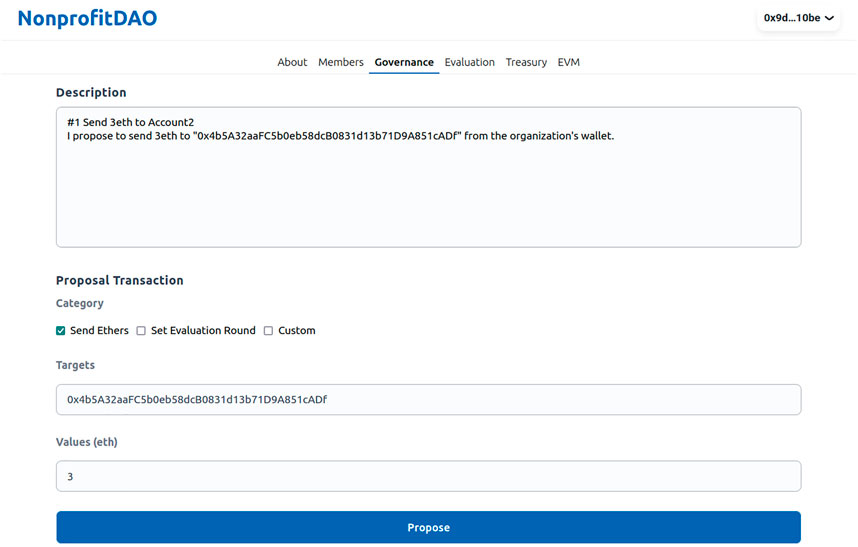
FIGURE 5. The proposal creation section in the front-end software. Any SBRT holder can make a proposal by sending the proposal’s description and proposal transaction to the blockchain.
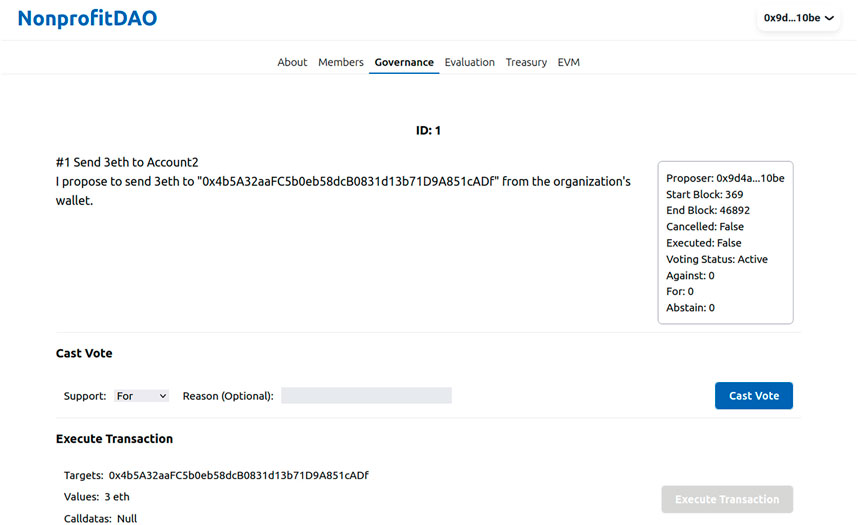
FIGURE 6. The proposal details section in the front-end software. Since the status is marked as Active, members can vote by selecting For, Against, or Abstain, along with the reason.
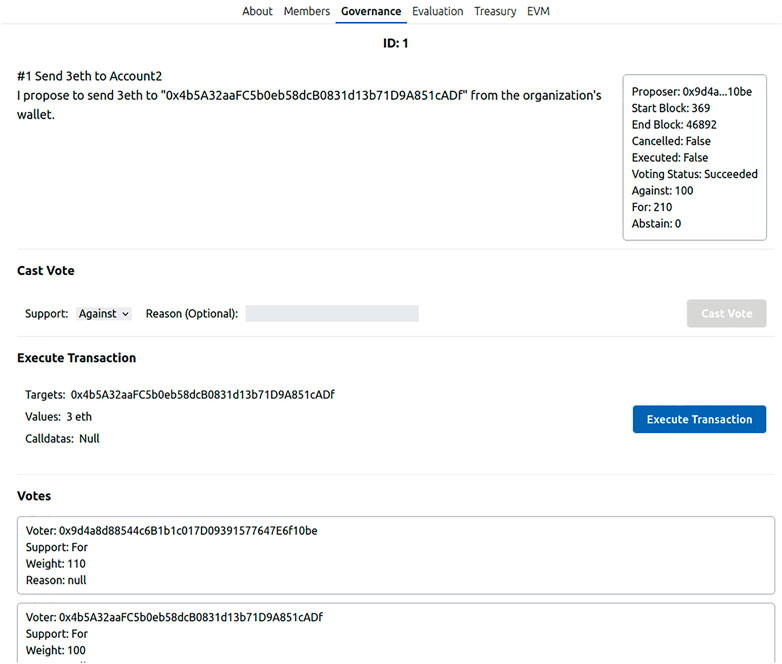
FIGURE 7. The proposal details section in the front-end software. As the status has changed to Succeeded, the Execute Transaction button is activated and the Cast Vote button is disabled. Anyone can confirm the voting history.
3.2 Demonstration of the evaluation system
The second use-case is the evaluation process. The evaluation proceeds as follows. First, Account1 proposes to set up a new evaluation round. The proposal succeeds and a new evaluation round is started, via the same process as in the previous demonstration. In this demonstration, three members randomly evaluate other members or Account4 and Account5 who are not SBRT holders (Figure 8). Once the results of the evaluations are sent to the blockchain, anyone can see the changes in the reputation counts (number of positive evaluations) and other activity counts, and the newly issued SBRTs from the website (Figure 9).
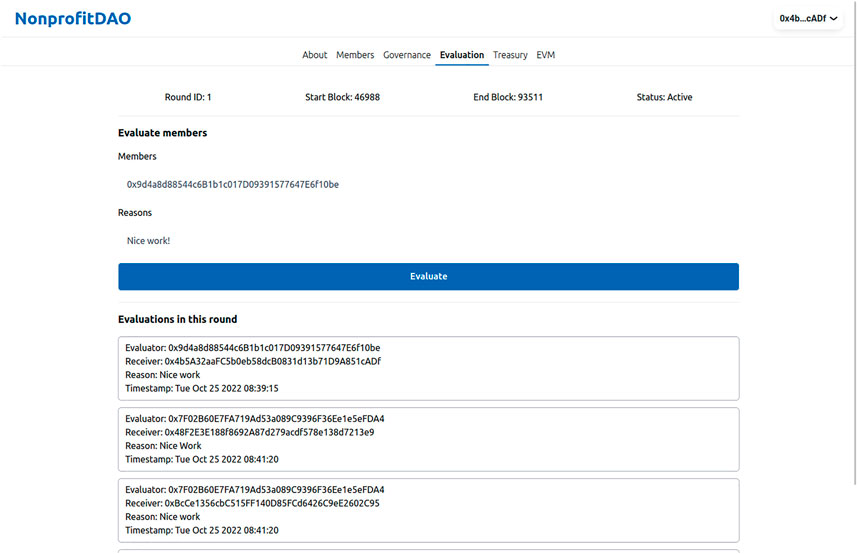
FIGURE 8. The evaluation section in the front-end software. All evaluation history is publicly available.
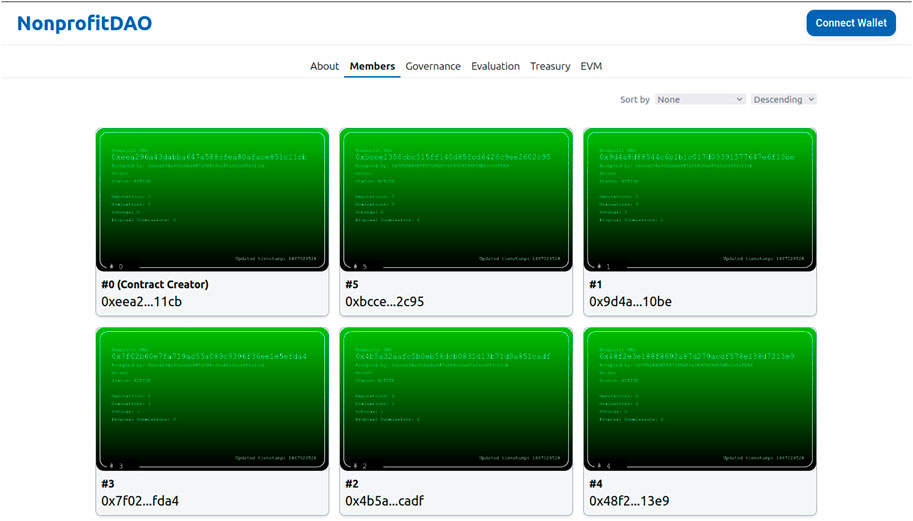
FIGURE 9. The members section in the front-end software. The SBRTs of all members can be viewed by anyone on the Internet, along with all details.
3.3 Demonstration of the donation process
In the last demonstration, Account6, who is not an SBRT holder and does not have sufficient resources such as time or knowledge to assist the organization’s activities, decides to provide financial support. Account6 can send ether to the GovernorNPO contract, which includes the organization wallet, using the Treasury section of the front-end software (Figure 10). When Account6 sends ether with a reference, anyone can confirm the amount and the reference. Similarly, when sending ether to another address from the organization’s wallet, anyone can trace the information.
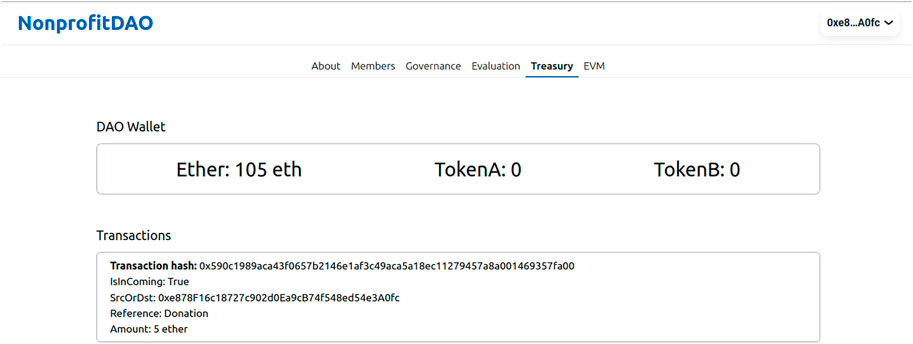
FIGURE 10. The finance section in the front-end software. Since 100 ETH was already pre-deposited at the time of contract creation and 5 ETH was donated from Account6, the organization now has 105 ETH.
4 Discussion
4.1 General discussion
4.1.1 Benefits
The demonstrations carried out in this study confirm that the DAO governance framework for non-profits brings transparency to the organization’s decision-making process and financial information. They also suggest that running an organization using smart contracts can reduce the operational costs of voting and accounting. These results support the work of Shin et al. (2020), who verified in a case study that non-profit organizations can operate efficiently and transparently by using blockchain. However, this study does not analyze how such transparency and efficiency affect donations and stakeholders’ trust-building on a DAO. Furthermore, the results suggest that building the decision-making process on a blockchain allows different actors to collaborate on the Internet. This ultimately changes the stakeholder relationships and breaks down the barriers between supporters, beneficiaries, and suppliers, allowing all actors to work together on the same footing. As Cooper (2014) and Hayase (2020) mention, participatory operations and stakeholder engagement are essential in operating non-profits. Moreover, anyone can create a DAO by forking existing battle-tested smart contract code. This enhances the ability of non-profits to foster civil society and respond to diverse demands.
4.1.2 Limitations
On the other hand, organizations formed on a blockchain have significant limitations. At the infrastructure (blockchain) layer, there are user experience and scalability challenges. The prototype in this study assumes that users would communicate with DAO contracts through a software tool called a wallet. However, even setting up and utilizing a wallet requires a complex process, and participating in a DAO may be difficult for many people. One example of an attempt to solve these problems is the use of smart contracts as wallets. Argent (Argent, 2022) provides users with self-custodial yet secure wallets via a smart contract wallet. While Ethereum wallets usually do not allow users to recover their wallets if they have lost their seed phrase (private key), Argent’s wallet provides a way to recover it without a seed phrase. Additionally, without understanding the complex technology of a blockchain, it is not easy to trust an organization, even if the organization’s operation is transparent. Futhermore, the scalability issues of blockchains represent another infrastructure layer limitation. It is quite unrealistic for an organization to require its members to pay a fee of several dollars to cast a single vote. Fortunately, it is generally believed that various scaling solutions will solve this problem in the near future.
At the application layer, as Marinelli (2019) and Buterin (2021) pointed out, any vulnerability in the code or bug in its design can easily cause an organization to lose its assets. In that regard, a DAO, where responsibilities are distributed, is particularly vulnerable to such risks. To properly align the interests of the various stakeholders, the design process requires cross-disciplinary knowledge in the technical, legal, financial, and economic fields. Moreover, since the solidity language and other blockchain-related development tools are immature, smart contracts that are in production need to be well-tested and audited by smart contract auditing companies.
Issues also exist outside of the blockchain. The law cannot be ignored when it comes to sound governance. Currently, DAOs are not generally recognized as legal entities, due to the absence of an administrator and ambiguous responsibilities, and neither DAOs nor donors can currently receive the tax benefits that are characteristic of non-profits. There is also substantial debate regarding tokens issued by DAOs.
4.2 Technical discussion on the governance system
The prototype in this study adopted a reputation-based voting system and NFT-based membership. The results indicate several concerns regarding the proposed governance system. The primary concern is the instability of the distribution system for governance power (reputations) due to the reliance on fragile human trust. While this system makes it easy for anyone to participate in the voting process, it also allows fraudulent users to infiltrate the organization. Furthermore, since only SBRT holders can create new SBRTs, once a rogue user obtains a tokenized reputation, there is a risk of a takeover attack. This would ruin the trustless nature of blockchain. While mutual trust is essential for good collaboration, the organization cannot ignore the existence of bad actors. To this end, the organization needs to filter out fraudulent accounts and optimize the distribution of voting rights. One way to solve this problem is to use Decentralized Identifiers (DIDs) and the global reputations of users. A DID is a cryptographically verifiable, globally unique identifier that is self-managed without reliance on third parties, using distributed networks such as a blockchain (W3C, 2022). By tying a global reputation to a DID, users would be able to accurately evaluate the likely ‘worthiness’ of other members by considering their previous contributions to other organizations. As a result, the risk of takeover attacks could be mitigated. However, since the development of DID is in its early stages, it can serve as a long-term solution only. Another solution to this problem is subdividing the reputation to prove specific types of contributions. Practical examples of this attempt are POAP (POAP, 2022) and RabbitHole (RabbitHole, 2022). POAP is a project that uses NFTs to issue certificates to users. For example, users who attend a project meeting are allocated tokens that prove their participation. RabbitHole is a project that creates a trusted resume on the blockchain by recording a user’s on-chain activities. Incorporating these services into an organization’s smart contracts could lead to a more accurate evaluation and distribution of governance power.
The second concern is that the decision-making process is not scalable. If an organization interacts with a diverse range of stakeholders, the organization’s decision-making process becomes much more complex, and a large number of proposals would have to be handled speedily and even precisely. The first solution to this problem is allowing users to delegate their voting power. Although a voting delegation feature has not been implemented in the current prototype due to time constraints, by implementing a delegation method, contributors who do not have either the knowledge or time to vote themselves can delegate their votes to knowledgeable participants. The second solution is adding a “priority” property to proposals, to increase scalability and make it easier for participants to participate in the voting process. For example, by permitting only users with many positive evaluations to propose high-priority proposals, an organization can assign priorities to tasks and operate efficiently. The third solution is categorizing reputations and votes into different domains, such as service development and public relations. For example, a member who has accumulated their reputation via positive evaluations in the service development domain could focus only on votes related to the service development domain and the organization as a whole, such as its finances. These solutions could allow the appropriate members to be involved in the right decisions, and accelerate the speed and efficiency of decision-making.
The current reputation-based governance system still has substantial scalability. For example, in combination with zero-knowledge proof technology, features such as anonymous donations, mutual negative reputation systems, and more complex, offchain secure voting power calculations can be added. Further examples include reputation-weighted evaluations and quadratic reputation voting.
4.3 Limitations and recommendations for future research
While this study represents a promising first step in establishing a DAO framework for reputation-based blockchain governance for non-profits, substantial work still remains. First of all, due to time constraints, this study could not test the effectiveness of utilizing the developed DAO to achieve the governance of non-profits through social experiments, and was instead focused on an essential demonstration of feasibility for the system, along with a discussion of associated behavior and concerns. In addition, although blockchain can compensate for some of the weaknesses of non-profits, it is not possible to measure its effectiveness without considering a number of other factors. Therefore, it would be necessary to actually implement a pilot project using a public testnet blockchain, rather than a private local blockchain, to confirm its effectiveness by surveying the participants and analyzing data from the arising reputation networks.
5 Conclusion
In this study, a prototype of a DAO governance framework for non-profits was implemented, and its key functionalities were tested via a set of exemplar demonstrations, in order to verify the essential feasibility of the system, and to identify its benefits and limitations. Firstly, the benefits were found to be: i) a blockchain brings transparency and efficiency to its operational process, ii) DAOs enhance global cooperation across stakeholders, and iii) DAOs can be used as a tool to improve the quality of life of non-profits. Secondly, in terms of limitations, this study found that: i) the user experience of blockchains, such as complexity and high transaction fees, may prevent organizations from considering adoption, ii) the operation of an organization with smart contracts may result in external or internal attacks, exposing the organization to real-world reputational risks, and iii) gaps between laws and organizations can prevent non-profit organizations from receiving tax benefits.
Although blockchain technology is still in its infancy, many developers and users have entered the market, and development is actively underway. The above limitations will be resolved as the technology develops. Accordingly, it is necessary to take a long-term perspective, and develop sustainable models of on-chain governance. Harnessing the trustless blockchain invented by Nakamoto to establish sound trust and cooperation is promising work for society.
Data availability statement
The datasets presented in this study can be found in online repositories. The names of the repository/repositories and accession number(s) can be found in the article/Supplementary Material.
Author contributions
YS and JR substantially contributed to the conception of the work. YS drafted the original manuscript. JR reviewed the manuscript draft and revised it critically for important intellectual content. All authors approved the final version of the manuscript to be published. All authors agree to be accountable for all aspects of the work in ensuring that questions related to the accuracy or integrity of any part of the work are appropriately investigated and resolved.
Funding
Open Access Fees for this publication will be partially defrayed by the Faculty Individual Research Funds kindly provided to JR by Ritsumeikan APU. In addition, open access fees may also be partially supported by funds to support publication costs from APU’s Research Office (JR contingent on paper acceptance, application, and approval).
Conflict of interest
The authors declare that the research was conducted in the absence of any commercial or financial relationships that could be construed as a potential conflict of interest.
Publisher’s note
All claims expressed in this article are solely those of the authors and do not necessarily represent those of their affiliated organizations, or those of the publisher, the editors and the reviewers. Any product that may be evaluated in this article, or claim that may be made by its manufacturer, is not guaranteed or endorsed by the publisher.
Footnotes
1OpenZeppelin is an open source framework for developing secure smart contracts in Solidity (https://www.openzeppelin.com/contracts).
2A proposal action is transaction data comprising a target address, ether value, and call data. A proposer can include this data in a proposal. Only when the proposal succeeds, they are assembled into a transaction and executed as a decision of the organization.
3A block number is an integer that indicates a block’s unique sequential number within the blockchain. The mining time for a block in Ethereum is roughly 1 every 13 s. Smart contracts can determine the block number at the point that one of their functions was called, and can use this data for time-related functions by calculating the approximate time. For example, 1 week can be represented as 46,523 blocks [(60 sec × 60 min × 24 h × 7 days)/ 13 s].
References
Aleman, M. (2021). El Salvador makes Bitcoin legal tender. Available at: https://apnews.com/article/caribbean-elsalvador-bitcoin-technology-business-ed51894baf9d47ec1093005602883fd9. (Accessed Oct 28, 2022)
Antonopoulos, A. M. (2017). Mastering bitcoin: Programming the open blockchain. 2nd edn. Sebastopol: O’Reilly Media.
Antonopoulos, A. M., and Wood, G. (2018). Mastering Ethereum: Building smart contracts and DApps. Sebastopol: O’Reilly Media.
Aragon (2022). Aragon home page. Available at: https://aragon.org/ (Accessed Oct 28, 2022).
Argent (2022). Argent home page. Available at: https://www.argent.xyz/ (Accessed Oct 28, 2022).
Buterin, V. (2014). DAOs, DACs, DAs and more: An incomplete terminology guide. Available at: https://blog.ethereum.org/2014/05/06/daos-dacs-das-and-more-an-incomplete-terminology-guide/ (Accessed Oct 28, 2022).
Buterin, V. (2021). Moving beyond coin voting governance. Available at: https://vitalik.ca/general/2021/08/16/voting3.html (Accessed Oct 28, 2022).
Compound (2022). Compound home page. Available at: https://compound.finance/ (Accessed Oct 28, 2022).
Cooper, K. R. (2014). Exploring stakeholder participation in nonprofit collaboration. Urbana, Illinois: University of Illinois at Urbana-Champaign.
Curve Finance (2022). Curve finance home page. Available at: https://curve.fi/ (Accessed Oct 28, 2022).
Dameron, M. (2019). Beige paper: An Ethereum technical specification. Available at: https://github.com/chronaeon/beigepaper/blob/master/beigepaper.pdf (Accessed Oct 28, 2022).
DAOstack (2018). An operating system for collective intelligence: White paper V1.1. Available at: https://daostack.io/wp/DAOstack-White-Paper-en.pdf (Accessed Oct 28, 2022).
Davies, R. (2015). Giving unchained: Philanthropy and the blockchain. London: Charities Aid Foundation. Available at: https://www.cafonline.org/docs/default-source/about-us-publications/givingunchained-philanthropy-and-the-blockchain.pdf (Accessed Oct 28, 2022).
Defi Llama (2022). Defi Llama web site: Total value locked (USD). Available at: https://defillama.com/ (Accessed Oct 28, 2022).
Ethereum.org (2022a). Decentralized finance (DeFi). Available at: https://ethereum.org/en/defi/ (Accessed Oct 28, 2022).
Ethereum.org (2022b). What are DAOs? Available at: https://ethereum.org/en/dao (Accessed Oct 28, 2022).
Gálvez-Rodríguez, M. D. M., López-Godoy, M., and Caba-Pérez, M. D. C (2020). “Accountability, transparency, and voluntary disclosure in nonprofit organizations,” in Financing nonprofit organizations:routledge Studies in the Management of Voluntary and non-profit organizations. Editors I. Garcia-Rodriguez, and M. E. Romero-Merino (London: Routledge), 48–61. doi:10.4324/9780429265419-6
Giga (2022). Giga home page. Available at: https://giga.global/ (Accessed Oct 28, 2022).
Gitcoin (2022). Gitcoin home page. Available at: https://gitcoin.co/ (Accessed Oct 28, 2022).
Government of Dubai (2021). Hamdan bin Mohammed: Dubai has become the world’s first paperless government. Available at: https://www.mediaoffice.ae/en/news/2021/December/11-12/Hamdan-bin-Mohammed-Dubai-has-become-the-worlds-first-paperless-government (Accessed Oct 28, 2022).
Government of El Salvador (2021). El Salvador prepara el terreno para la circulación general del Bitcoin, en medio de expectativas positivas de inversión [El Salvador paves the way for general Bitcoin exchange amid positive investment expectations]. Available at: https://www.presidencia.gob.sv/el-salvador-prepara-el-terreno-para-la-circulacion-general-del-bitcoin-en-medio-de-expectativas-positivas-de-inversion/ (Accessed Oct 28, 2022).
Grauer, K., Kueshner, W., and Updegrave, H. (2022a). The chainalysis 2022 crypto crime report. New York: Chainalysis.
Grauer, K., Kueshner, W., and Updegrave, H. (2022b). The chainalysis 2022 geography of cryptocurrency report. New York: Chainalysis.
Hassan, S., and De Filippi, P. (2021). Decentralized autonomous organization. Internet Policy Rev. J. Internet Regul. 10, 1–10. doi:10.14763/2021.2.1556
Hayase, S. (2020). “NPO no Jyokyo to Shiensosiki [Situation and support organizations of NPOs],” in NPO/NGO no Sekai [The World of NPOs and NGOs]. Editors M. Ohashi, and Y. Tonegawa (Japan: The Open University of Japan), 52–70.
KlimaDAO (2022). KlimaDAO home page. Available at: https://www.klimadao.finance/ (Accessed Oct 28, 2022).
Levi, A. (2019). Reputation vs tokens. Available at: https://medium.com/daostack/reputation-vs-tokens-6d7642c7a538 (Accessed Oct 28, 2022).
MakerDAO (2022). MakerDAO home page. Available at: https://vote.makerdao.com/ (Accessed Oct 28, 2022).
Malak, L. A. (2021). Blockchain integral element in Dubai government paperless success. Available at: https://www.unlock-bc.com/82553/blockchain-integral-element-in-dubai-government-paperless-success/ (Accessed Oct 28, 2022).
Marinelli, I. V. A. (2019). Blockchain technology applications for financial transparency in non profit organizations. Sao Carlos: ICMC. Available at: https://repositorio.usp.br/directbitstream/d060ac4e-7d70-4cc2-84a5-79feabeb9e32/IgorMarinelli_ProjetoGraduacao_2.pdf (Accessed Oct 28, 2022).
Mart, J., and Yi, R. (2021). On the value and risks of governance tokens. Available at: https://www.coinbase.com/learn/market-updates/around-the-block-issue-13 (Accessed Oct 28, 2022).
Nakamoto, S. (2008). Bitcoin: A peer-to-peer electronic cash system. Available at: https://bitcoin.org/bitcoin.pdf (Accessed Oct 28, 2022).
Parton, N. (2021). Decentralized governance overview. Available at: https://wiki.withtally.com/docs/compound-governor (Accessed Oct 28, 2022).
POAP (2022). POAP home page. Available at: https://poap.xyz/ (Accessed Oct 28, 2022).
Price, N. (2017). How to ensure good governance for your nonprofit. Available at: https://www.boardeffect.com/blog/how-ensure-good-governance-nonprofit/ (Accessed Oct 28, 2022).
RabbitHole (2022). RabbitHole home page. Available at: https://rabbithole.gg/ (Accessed Oct 28, 2022).
Rea, A., Kronovet, D., Fischer, A., and du Rose, J. (2018). Colony technical white paper. Available at: https://colony.io/whitepaper.pdf (Accessed Oct 28, 2022).
Saito, Y. (2022). Reputation-based nonprofit DAO source code on GitHub. Available at: https://github.com/yoshsa17/nonprofit-dao/tree/v1.
Salamon, L. M. (1987). Of market failure, voluntary failure, and third-party government: Toward a theory of government-nonprofit relations in the modern welfare state. Nonprofit Voluntary Sect. Q. 16, 29–49. doi:10.1177/089976408701600104
Schär, F. (2020). Decentralized finance: On blockchain- and smart contract-based financial markets. SSRN 103. doi:10.2139/ssrn.3571335
Shin, E.-J., Kang, H.-G., and Bae, K. (2020). A study on the sustainable development of NPOs with blockchain technology. Sustainability 12, 6158. doi:10.3390/su12156158
Snapshot (2022). Snapshot home page. Available at: https://snapshot.org/ (Accessed Oct 28, 2022).
Stroponiati, K., Abugov, I., Varelas, Y., Stroponiatis, K., Jurgeleviciene, M., and Savanth, Y. (2020). Decentralized governance in DeFi: Examples and pitfalls. Tech. rep. Lithuania: DappRadar (Accessed Oct 28, 2022).
Turfa, M. (2019). The usage of decentralized applications for enhancing the donation process. Stuttgart: University of Stuttgart. Available at: https://elib.uni-stuttgart.de/bitstream/11682/10262/1/bachelor-thesis-Turfa.pdf (Accessed Oct 28, 2022).
W3C (2022). Decentralized identifiers (DIDs) v1.0. Available at: https://www.w3.org/TR/did-core/ (Accessed Oct 28, 2022).
Weyl, E. G., Ohlhaver, P., and Buterin, V. (2022). Decentralized society: Finding web3’s soul. (SSRN). doi:10.2139/ssrn.4105763
Xie, L. (2021). A beginner’s guide to DAOs. Available at: https://linda.mirror.xyz/Vh8K4leCGEO06_qSGx-vS5lvgUqhqkCz9ut81WwCP2o (Accessed Oct 28, 2022).
Yeo, A. C. M., Chong, Y., and Carter, S. (2017). Governance practices and disclosure by not-for-profit organizations: Effect on the individual donating decision. In Empowering 21st century Learners through Holistic and enterprising learning. Editors G. B. Teh, and S. C. Choy (Singapore: Springer), 243–254. doi:10.1007/978-981-10-4241-6_25
Keywords: blockchain, Ethereum, non-profit organization, DAO, good governance, smart contract, reputation-based voting, soulbound tokens
Citation: Saito Y and Rose JA (2023) Reputation-based Decentralized Autonomous Organization for the non-profit sector: Leveraging blockchain to enhance good governance. Front. Blockchain 5:1083647. doi: 10.3389/fbloc.2022.1083647
Received: 29 October 2022; Accepted: 14 December 2022;
Published: 11 January 2023.
Edited by:
Imtiaz Khan, Cardiff Metropolitan University, United KingdomReviewed by:
Henry Michael Kim, York University, CanadaOskar Josef Gstrein, University of Groningen, Netherlands
Copyright © 2023 Saito and Rose. This is an open-access article distributed under the terms of the Creative Commons Attribution License (CC BY). The use, distribution or reproduction in other forums is permitted, provided the original author(s) and the copyright owner(s) are credited and that the original publication in this journal is cited, in accordance with accepted academic practice. No use, distribution or reproduction is permitted which does not comply with these terms.
*Correspondence: Yoshiro Saito, eW9zaHNhMTdkZW5AZ21haWwuY29t
 Yoshiro Saito
Yoshiro Saito John A. Rose
John A. Rose